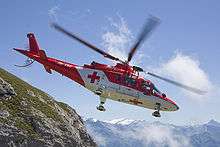Loss of tail-rotor effectiveness
Loss of tail-rotor effectiveness (LTE)[1] occurs when the tail rotor of a helicopter is exposed to wind forces that prevent it from carrying out its function—that of cancelling the torque of the engine and transmission. Any low-airspeed high-power environment provides an opportunity for it to occur.
Causes
Environmental factors which can lead to LTE include higher operating-density altitudes or temperatures, and high winds. A high gross weight can also create an LTE-conducive situation. Causative wind-directions may include:
- Main-rotor vortexes pushed into the tail rotor by wind. This can occur with wind coming from 10 o'clock on North American (counter-clockwise) rotors and from 2 o'clock on clockwise rotors. The wind pushes the dirty air and vortexes generated from the main-rotor into the tail-rotor, preventing the tail rotor from having clean air to propel.
- Wind from the tail (6 o'clock) can cause the helicopter to attempt to weathervane into the wind. The winds passing on both sides of the tail rotor make it teeter between being effective (providing thrust) and ineffective (not providing thrust). This creates a lot of pedal work for the pilot to eliminate unintended yaw.
- Wind moving in the same direction as the tail rotor moves air. With pusher tail-rotors, that is wind from the opposite side of the tail-rotor. With puller tail-rotors, that is wind from the same side as the tail rotor. For main rotors with clockwise rotation (European), that is wind from 3 o'clock. For main rotors with counter-clockwise rotation, that is wind from 9 o'clock. The wind going through the tail rotor causes an actual stall condition as it decreases the effective airspeed of the air through the tail rotor. This condition will cause an unintended yaw that may develop into a spin. Recovery from this condition may be difficult if no airspeed is available, and will require entry into an autorotation (thus removing the torque of the engine and transmission).
Indications of onset
Many factors affect the onset of LTE, but no matter which way it occurs, the clues are present:
- An environment of low airspeed, and a demand for power.
- An unintended yaw that may even be opposite to pedal input.
Recovery
Recovery is initiated by increasing airspeed, using the vertical stabilizer to reduce yaw or, if uncorrectable by application of speed or tail-rotor thrust, entry into autorotation. Note that a full autorotative landing isn't necessary—the mere entry into autorotation will eliminate the torque, and then the spin or yaw will reduce through friction, particularly with the buildup of forward speed. At that point power recovery (while maintaining airspeed) can be successfully accomplished.
See also
References
- ↑ Rotorcraft Flying Handbook Section 11-12, Federal Aviation Administration, Skyhorse Publishing (July 2007) ISBN 978-1-60239-060-7
